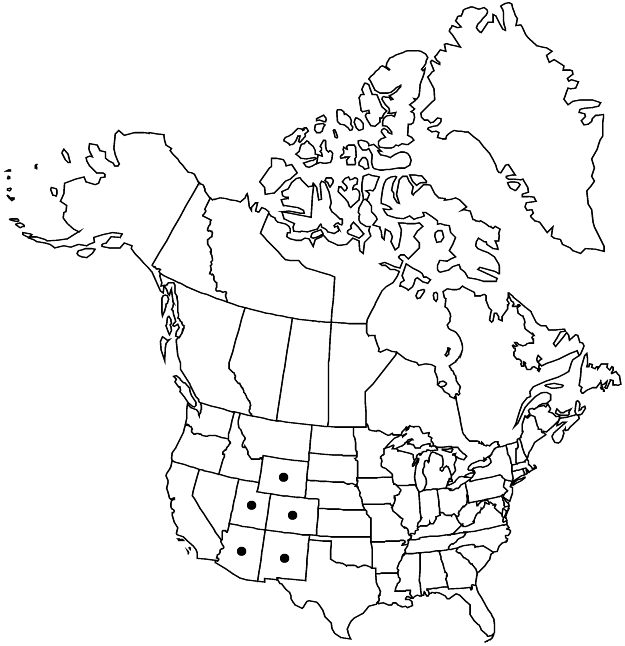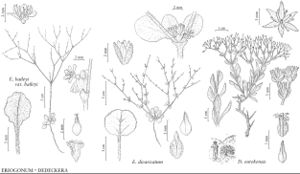Eriogonum divaricatum
Hooker’s J. Bot. Kew Gard. Misc. 5: 265. 1853.
Herbs, spreading, 1–2(–3) dm, puberulent to short-pilose, greenish to reddish. Stems: aerial flowering stems decumbent to spreading, 0.3–0.5 dm, puberulent to short-pilose. Leaves basal and cauline; basal: petiole 1–4(–5) cm, puberulent to short-pilose, blade elliptic-oblong to orbiculate, 1–2(–2.5) × 1–2(–2.5) cm, puberulent to short-pilose and green on both surfaces; cauline: petiole (0–)0.1–2 cm, puberulent to short-pilose, absent distally, blades opposite, oblanceolate to oblong or elliptic, 0.3–1(–1.5) × 0.2–0.8(–1.2) cm, similar to basal blade. Inflorescences cymose, distally uniparous due to suppression of secondary branches, diffuse, 5–25 × 10–45 cm; branches puberulent; bracts 1–3(–5) × 1–2 mm. Peduncles absent. Involucres somewhat appressed to branches, campanulate, 1–2 × 1–2 mm, pilose; teeth 5, lobelike, spreading to somewhat reflexed, 0.7–1.5 mm. Flowers (1–)1.5–2 mm; perianth yellow, rarely pale yellow, hispidulous and glandular with yellowish-white hairs; tepals monomorphic, oblong-lanceolate to oblong-ovate; stamens included, 0.7–1.5 mm; filaments pilose proximally. Achenes light brown, 3-gonous, 1.5–2 mm.
Phenology: Flowering May–Oct.
Habitat: Heavy clay flats and slopes, saltbush, greasewood, and sagebrush communities, pinyon-juniper woodlands
Elevation: 1100-2300(-2500) m
Distribution

Ariz., Colo., N.Mex., Utah, Wyo.
Discussion
Eriogonum divaricatum basically is a species of the Colorado Plateau of southwestern Wyoming (Sublette, Sweetwater, and Uinta counties), eastern Utah (Carbon, Emery, Garfield, Grand, Kane, San Juan, Sevier, and Wayne counties), western Colorado (Mesa and Montezuma counties), northern Arizona (Apache, Coconino, and Navajo counties), and northwestern New Mexico (McKinley and San Juan counties), where it is infrequent to common but only rarely abundant. There are several disjunct populations well removed from that core area; the species occurs in Beaver and Millard counties of west-central Utah, and in Clayhole Valley, Mohave County, Arizona. In New Mexico, it was found around San Ysidro, Sandoval County, in 1926. The most extreme disjunctions were two populations found in Argentina during the growing season of 1899–1900. Those plants were named Eriogonum ameghinoi Spegazzini, which ultimately became the only species of the genus Sanmartinia M. Buchinger. Probably introduced there by migrating birds, the species did not persist in South America (J. L. Reveal 1981b).
The divergent wild buckwheat was used ceremonially by the Navajo (Diné) people in one of their snake dances, and portions of the plant were smoked in the treatment of snakebite (A. Clifford, pers. comm.; L. C. Wyman and S. K. Harris 1951).
Selected References
None.
